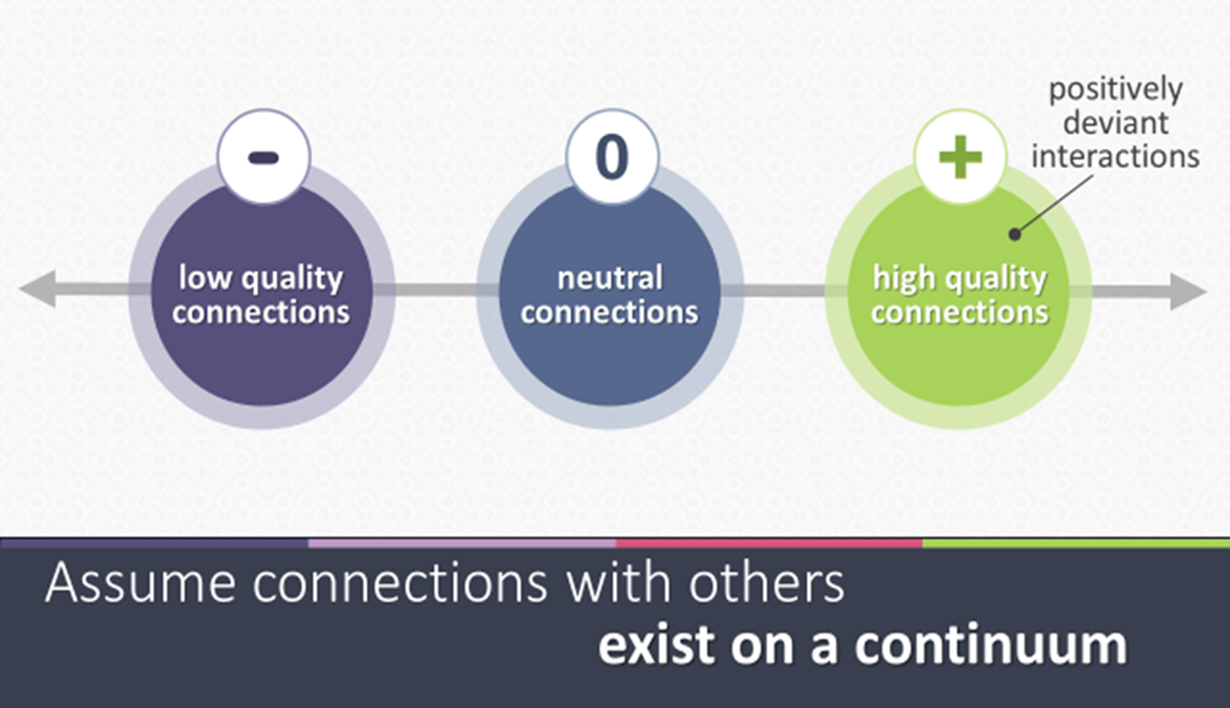Three years ago, we met a woman named Denise when we visited her organization to offer a workshop. Denise shared her passion for learning about organizational culture and culture change. We had a brief, energizing conversation about how she was transferring what she was learning about culture change at work to her volunteer role at her daughter’s school.

Fast forward to earlier this month, when we were back at the same organization and bumped right into Denise! We greeted her enthusiastically and shared how wonderful it was to see her again. We asked about her daughter, and what was new in the culture change space. Later, as we said goodbye, Denise admitted something important: “I’m surprised you remembered me and even knew my name,” she confessed. “It is touching that you remembered what I care about, as so few people seem to do that. Thank you.”
Our experience with Denise might seem very ordinary, yet it also illuminates what we call in our research “high-quality connections.” Denise’s comments emphasize the scarcity of these connections in many work environments. Time and performance pressures, inattention, distraction, and overload can easily undermine our ability to connect.
While easy to overlook, these momentary interactions are highly consequential. As researchers, we’ve collected evidence about four important pathways that can help you foster high-quality connections—and be healthier, happier, and more productive at work and beyond.
Not all connections are alike
Some forms of human connection nourish and sustain us more than others. It may help to think of our momentary interactions with other people along a continuum that spans from low-quality connection to neutral to high-quality.
We know the quality of connection by how we feel while we are in it. Higher-quality connections “light us up” with energy and a sense of vitality as we mutually respond to one another. They also involve what psychologist Carl Rogers called unconditional positive regard, seeing one another in a favorable and accepting manner.
A mountain of evidence demonstrates the importance of human connections marked by these three characteristics. They increase our overall health, well-being, and sense of belonging, bolster our psychological safety, make us and our teams more resilient, and even contribute to our longevity. In fact, it is probably not overstating the case to say that we are on this earth to connect with one another.
Connections are different from relationships. Think about them as the micro-bits that link us to strangers, but also color and shape the moments in longer-term, more enduring relationships. If we want to shift the quality of our relationships, we must shift the quality of the moments of interaction that comprise those relationships. When we experience more vitality, greater mutual responsiveness, and higher levels of positive regard together, our relationships grow stronger.
While changing patterns of relating can seem difficult or even impossible, watching for moments of high-quality connection gives us places to start. We can actively engage in actions that pave the way for these connections to emerge. We have articulated four pathways to high-quality connection by examining and synthesizing many years of diverse, multidisciplinary research, creating a map to the conditions that are most supportive for them.
1. Respectful engagement
A required condition for high-quality human connection is to see another person as worthy or valuable. Respect is like a gift of social worth, a gift that is given by how we treat each other.
We communicate respect, or fail to communicate it, in many kinds of small moments. Consider the many ways we signal our presence to another person—giving them our full attention, tuning in to them, removing distractions, making eye contact, and listening actively. When we aren’t fully present with another person, they feel it.
In work contexts, we bestow respect when we convey that we’ve genuinely heard someone, using bodily gestures such as nodding or smiling. We can ask questions to engage with genuine interest and curiosity. And, finally, we convey respect when we affirm others. When we see and value the good in another person, reflected in how we introduce them or recognize them, they are much more likely to feel respected.
If you look closely at our brief interaction with Denise, you can see a great deal of respectful engagement. Small but crucial moves include conveying our full presence as we actively greeted each other, expressing interest through our memories of a prior interaction, and showing curiosity reflected in questions about Denise’s daughter and her passions and interests. Though our interaction was momentary, Denise’s feedback to us about the connection reveals the power of a few moments of respectful engagement.
We created this high-quality connection in just seconds—but don’t let that fool you. It wasn’t accidental. We can’t overstate the importance of moves that can seem insignificant if you are in a hurry or under strain, such as a respectful smile, a nod, remembering a name, asking a question, or conveying an expression of delight. People have a basic need to belong, and being affirmed by others helps them know they are included. When this type of connection is a rarity in our work, low-quality connections and disrespectful interactions pave the way toward burnout, disengagement, and a sense that our work doesn’t matter and we don’t belong in our workplace.
2. Task enabling
In our research, we use the term task enabling to refer to different ways we help another person succeed in what they are trying to do. There are as many ways of task enabling as there are people who need help, but we can learn a few small moves that are particularly potent for building higher-quality connections along this pathway.
First, we can consider and provide resources. Resources can be money or material goods, but more often they are non-material support, such as providing attention, encouragement, information, or mentorship. We might provide an introduction or help identify new sources of support. All of these moves not only aid in doing the task, but also convey that we care about the other’s success.
Similarly, we can task-enable by considering ways to remove obstacles that hinder someone in accomplishing what they set out to do. Making things easier fosters a higher-quality connection, not just by lending a hand but also by conveying our understanding of their situation.
In workplaces, this kind of helping creates conditions for high-quality connections to blossom. You can easily imagine that in our conversations with Denise, as we learned of her passion for organization culture change, we could enable her work by introducing her to a community of practitioners who meet regularly to discuss the trials and triumphs of culture change. Further, we could make a few phone calls to remove constraints blocking her participation as a relatively junior member, making her journey easier. Denise felt grateful and delighted by our efforts to help her grow, and our connection was elevated to a new level.
3. Trusting
Most of us intuitively understand the importance of trust, by which we convey our belief that another person is reliable, capable, and caring. Actively trusting builds the quality of our connections, because when trust is present in a connection, people feel safer. Many of us value being trusted by others, but we may not know how to communicate that we are trusting of others. Learning a few new small moves that signal trusting can give your connections a substantial boost in quality.
We communicate that we are trusting when we give others control over resources or decisions. In the workplace, this is often reflected in a lack of “micromanagement,” allowing people to do work in ways that make sense to them. As colleagues, peers, or managers and leaders we can say—in both words and deeds—that we believe in someone’s intentions and integrity and that we stand behind their capacity to do what is needed.
Workplaces also create many opportunities for trusting and communicating trusting in the sharing of information. We communicate trusting when we are transparent or open with others about our intentions and about our circumstances. For example, when a principal shares with her full teaching staff that there will be a need for budget tightening this year and gives each teacher control over how they execute the cuts in their classroom, there is an uptick in the amount of trust in the connection. By giving another person more control, we are inherently making ourselves more vulnerable. Our willingness to be vulnerable conveys a type of faith in the other person and also signals our belief in their benevolence and capability.
4. Playing
The fourth pathway to higher-quality connections involves playfulness. All humans play to learn and grow. We often stop regarding play as legitimate when we join the workforce. But playing matters for connection!
By playing, we simply mean creating fun or enjoying pleasant experiences in an appropriate manner that fits with what we are doing in a momentary interaction. In our interaction with Denise, playing took the form of smiles, humorous stories, and some shared laughter. For other work teams, playfulness might take the form of getting out of the office into a different setting together, playing online games, or going on a shared adventure. We studied one work team that established a norm allowing anyone who sensed the team was overly stressed to call for an immediate, short, fun dance break. Another team, who worked in an area with frequent cold weather, took “sunshine breaks” as a form of playing together any time the sun broke through the cold clouds.
Small moments of playfulness or fun might seem insignificant at work, but like the other moves described in these four pathways, what is small is also mighty.
Experiment, seek feedback, and grow your connection capacity
While we are born to connect, we don’t always know how to engage in high-quality connections in the midst of uncertainty. Deliberate attention to these small moves is harder when we’re busy or under pressure. We may avoid interacting with people in spaces that are unfamiliar or uncomfortable, losing the opportunity for moments of high-quality connection.
Luckily, we can learn to more intentionally practice all of the small moves along these four pathways. We invite you to try something new in your connections today and to use whatever happens as feedback to learn and grow. As you seek to connect in higher-quality ways, you can become ever more skillfully human.
Once you start practicing new ways to show respectful engagement, communicate trust, play together, and enable others to succeed, you’ll quickly find that learning how to connect can be a lifelong quest that makes our working lives more fulfilling, healthy, and meaningful.








Comments